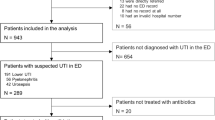Abstract
In order to evaluate the effect of the introduction of recent similar guidelines on the treatment of acute urinary tract infection (UTI) in children, and possible changes in its epidemiology, we analyzed the records of hospital discharge for acute UTI under the age of 15 years in England and Wales between 1979 and 1993 and in Finland between 1978 and 1994. Cases were defined by the ICD9 diagnostic codes 590.1 (acute pyelonephritis) and 599.0 (UTI, site not specified) for males and females according to three age groups (0–4, 5–9, and 10–14 years). We also compared the registry data on kidney transplants due to end-stage renal disease caused by recurrent pyelonephritis in the United Kingdom and Finland. In England the rate of attack of symptomatic UTI per 1,000 girls under 15 years increased from 0.74 (95% confidence interval 0.71–0.76) in 1987 to 1.32 (1.29–1.35) in 1993 (P<0.001, test for trend). The respective figures for Finnish girls were 1.74 (1.62–1.86) in 1987 and 1.62 (1.51–1.74) in 1993 (P=0.72). In English boys, the increase in the attack rate was from 0.38 (0.36–0.40) in 1987 to 0.70 (0.68–0.73) in 1993 (P<0.001). In Finnish boys the respective figures were 0.74 (0.66–0.82) in 1987 and 0.88 (0.80–0.97) in 1993 (P<0.02). The observed increases in the attack rates of UTI most probably relate to increased referral of acute UTI patients to hospitals for the recommended imaging studies rather than changing occurrence. Publication of guidelines for treatment of UTI in children, consolidating more-general awareness, may have contributed to this. The mean annual numbers of kidney transplants in the United Kingdom and Finland during 1989–1995 due to end-stage renal disease caused by pyelonephritis were of similar magnitude, i.e., 1.9 (1.6–2.3) transplants per million inhabitants in the United Kingdom and 2.8 (1.5–4.7) transplants per million inhabitants in Finland. The decreasing trend in these figures in both countries, although statistically significant only in the United Kingdom (P<0.05, test for trend), suggests improved long-term outcome of these patients induced by better diagnosis and treatment of pyelonephritis and the diseases related to it, such as congenital malformations. According to our data, valid clinical guidelines are effective in changing clinical practice.
Similar content being viewed by others
Author information
Authors and Affiliations
Additional information
Received: 1 September 1997 / Revised: 29 April 1998 / Accepted: 29 April 1998
Rights and permissions
About this article
Cite this article
Nuutinen, M., Uhari, M., Murphy, M. et al. Clinical guidelines and hospital discharges of children with acute urinary tract infections. Pediatr Nephrol 13, 45–49 (1999). https://doi.org/10.1007/s004670050560
Issue Date:
DOI: https://doi.org/10.1007/s004670050560




